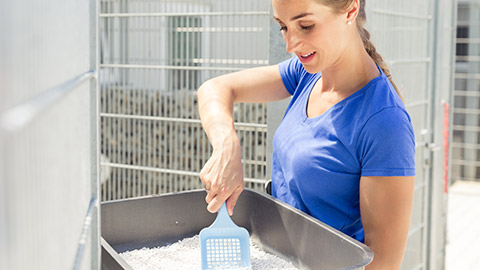In Module One we briefly mentioned the Health and Safety legislation that applies to workplaces in Aotearoa New Zealand. We’re now going to look more closely at this legislation, and what it means for you if you are a worker (including volunteers) in the animal care industry. If you are not yet working in the industry, then many of the points we are going to cover will still be useful for you, especially the actions that can be taken to make sure you and your companion animals stay safe – they apply to non-work contexts as well.
This Act, often shortened to HSWA 2015, exists to ensure that New Zealand workplaces are as safe as they possibly can be. It’s very similar to legislation that exists in Australia but there are key differences that reflect the unique New Zealand working environment. It’s a large piece of legislation with many parts to it. You can find it here: Health and Safety at Work Act 2015 No 70 (as at 24 August 2023), Public Act Contents – New Zealand Legislation
| Purpose: | To provide for a balanced framework to secure the health and safety of workers and workplaces. |
| Enforced/Administered by: |
|
| Key Points: |
|
The following presentation was put together by Work Safe New Zealand. The website (Home | WorkSafe) for this government department is very informative and has lots of resources for both workers and employers. It’s definitely worth spending some time browsing through it.
Watch: Health & Safety at Work Act presentation (23:41 minutes)
In this video, Gordon MacDonald, former Chief Executive of WorkSafe NZ, gives an overview of the HSWA, why the Act exists and basic facts about the Act that everyone needs to know.
Questions
Pre-Watch Question: There are lots of facts and figures in this presentation, so prepare to take notes. Here are the most important things from this video that you need to listen for:
- Health and safety-related deaths in New Zealand.
- How we compare to Australia and the UK.
- What is more important: health or safety?
- Do we have an attitude problem in New Zealand?
- What’s the aim of the implementation of the HSWA?
- Who is responsible for Health and Safety?
- What managing risk is about.
Download the speaker notes if you would prefer to read the information from the presentation.
Post-Watch Task: How much do you remember from the presentation? Complete the following learning activity. The questions are either multi-choice, true/false or Yes/No.
Potential Penalties for Breaching HSWA 2015
The Act makes it clear that health and safety in New Zealand is taken very seriously. The penalties are much higher than in the other legislation that we have looked at in this Module.
For Death or Serious Injury
- Individuals (not PCBUs): up to $150,000.
- PCBUs or Officers of a PCBU: up to $300,000
For Reckless Conduct Resulting in the Risk of Death or Serious Injury
- Individuals (not PCBUs): imprisonment up to five years, or a fine of an amount up to $300,000 (or both)
- An individual who is a PCBU or an officer of a PCBU: imprisonment not exceeding five years or a fine of an amount up to $600,000 (or both)
- Other person/company: a fine of an amount up to $3 million.
Non-Financial Penalties
These can include:
- adverse publicity orders where the person or company at fault must publicise the offence, its consequences, and the penalty imposed;
- restoration orders where the person or company at fault must make amends for any issue caused by the offence;
- project orders where the person or company at fault must implement a project of general improvement of health and safety in their workplace; or
- court-ordered enforceable undertakings, where the person or company at fault must follow particular rules or conditions for a set period of time
Legal Responsibilities for PCBUs (person conducting a business or undertaking)
Under the Act employers have a ‘primary duty of care’, which means that they are responsible for the health and safety of their workers. The PCBU must make sure that the workplace is safe for workers and other people who are at the workplace. This includes the environment and any equipment and tools that are used. The conditions and health of the workers must be monitored to ensure that injury or illness is prevented. The PCBU is also responsible for the appropriate training of workers.
In Module One we discussed some of the hazards that you might be exposed to while working in an animal care related role. Let’s quickly recap what was covered. Use your mouse to drag the correct word/s into the spaces in the paragraph below.
Workplace Monitoring
This could include:
- measuring a hazard (eg a substance, fumes, noise or vibrations arising from the work)
The purpose of the monitoring:
- is to assess the effectiveness of controls being used to minimise the risk of workers developing a work-related condition or getting injured
Health Monitoring
This could include:
- specific and targeted testing of the health of workers to identify any signs of potential harm to their health
The purpose of the monitoring:
- identifying the development of work-related conditions
- assess the effectiveness of control measures designed to minimise potential harm to worker health
Compensation for Workplace Injuries and Accidents
In New Zealand, ACC (Accident Compensation Corporation) covers this. Your employer must pay the first week of your salary if you cannot work due to an accident/injury, then remaining weeks are covered by ACC (up to 80% or your salary or wages), for a defined period. In some instances, a lump sum payment may apply.

In the WorkSafe video, we learned that workers have three key responsibilities when it comes to health and safety in the workplace. These are:
- To take reasonable care to keep themselves and others safe.
- To follow any reasonable health and safety instructions given by the business.
- To cooperate with any reasonable business policy and procedures.
It’s the last two bullet points that we are going to focus on now. In Module One we were introduced to the terms ‘policy’ and ‘procedure’, and now we are going to look more closely at what following and cooperating with these means for workers in the animal care industry. Move onto Topic 3 to find out more.
